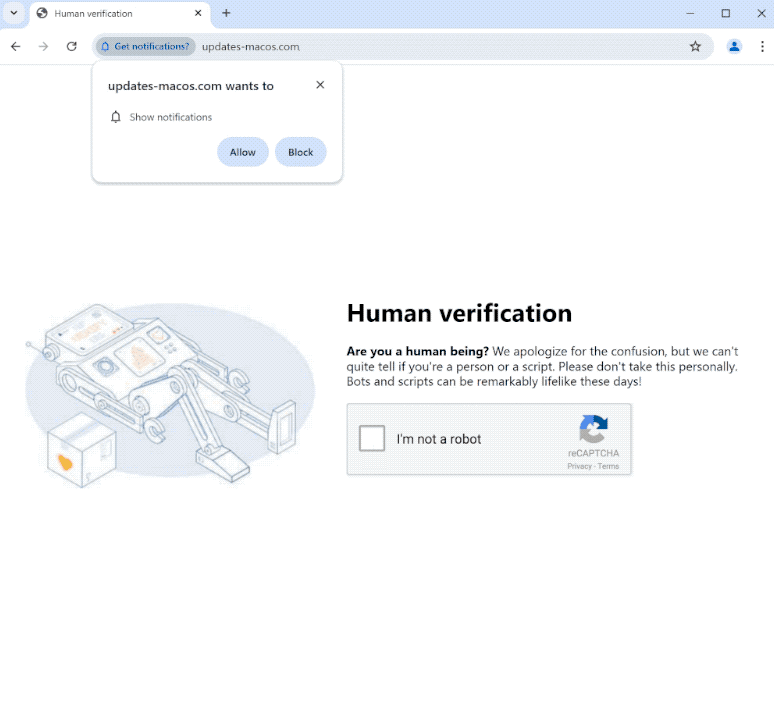update-macos.com is a deceptive website that misuses a legitimate browser feature to spam ads on users’ desktops. When users get redirected to the site, they will immediately get a browser alert saying “update-macos.com wants to show notifications”. Clicking “Allow” will give the site permission to show notifications on the desktop.
Besides a robot check, update-macos.com is completely empty. Upon being redirected to it, you will immediately get a browser alert saying “update-macos.com wants to show notifications”. The “show notifications” feature is legitimate and can even be useful but it is misused by dubious sites like update-macos.com. If you give update-macos.com permission to show notifications, it will spam them on the right side of the screen, even when you exit the website. They will appear similarly to where legitimate system notifications are displayed, which may confuse some users and trick them into interacting with them. We don’t recommend clicking on those notifications because you could be taken to questionable or even malicious websites that conceal malware or promote scams.
If you have given the site permission to show notifications, instructions for how to revoke it are provided at the end of the report.
Why are you redirected to sites like update-macos.com?
Redirects to sites like update-macos.com are usually triggered either by an adware infection or by the sites users browse. The latter is more common, but if redirects are happening constantly, it may be a symptom of adware. Certain sites, especially ones with pirated or pornographic content, try to expose users to as much advertisement content as possible. That includes spamming ads and triggering redirects. Clicking on anything when on those sites will usually trigger a redirect. Fortunately, you can easily block these redirects with a decent adblocker program.
In rarer cases, redirects to update-macos.com may also be a sign of an adware infection. Adware, browser hijackers, and similar infections are installed accidentally by users via a method known as software bundling. The way this method works is said infections are added to popular free programs as additional offers. These offers are set to be installed alongside the programs they’re attached to automatically and do not require explicit permission.
To stop the added offers from installing, you need to manually deselect them when installing a program. The offers are optional but they are hidden in settings users don’t usually use, which is why software bundling is a rather deceptive installation method. If you pay attention when installing free programs, it will be easy to prevent these unwanted installations. When installing a program, choose Advanced (Custom) settings instead of Default (Basic). The installation window recommends using Default settings but Default settings conceal all added offers and allow them to be installed automatically.
Advanced or Custom settings will not only clearly display what has been added but also give you the option to deselect the offers you do not want. Keep in mind that even if some offers initially appear useful, it’s not a good idea to allow their installations. Legitimate programs do not use software bundling to install, and those that do are often detected as potential threats by anti-virus programs. If you allow these installations, you will only fill your computer with junk programs.
How do I stop update-macos.com notifications?
It’s strongly recommended to scan your computer with an anti-virus program to check for an adware infection because that could be why you’re being redirected. Adware can be annoying to remove manually so our suggestion is to use an anti-virus program. You also need a good adblocker program to block redirects and other ad content.
If you have given update-macos.com permission to show you notifications, you can easily revoke it in your browser’s settings. If you need help navigating the settings, use the instructions provided below. If you don’t plan on using this feature, you can also turn off the notification requests altogether.
If you have given the site permission to show notifications, here’s how to revoke it:
- Mozilla Firefox: Open the menu (the three bars at the top-right corner), click Options, then Privacy & Security. Scroll down to Permissions, press Settings next to Notifications, and remove update-macos.com and any other questionable websites from the list. It’s possible to permanently turn off push notification requests by checking the “Block new requests asking to allow notifications” box in the same Notifications settings.
- Google Chrome: Open the menu (the three dots top-right corner), then Settings, then Privacy and security, then Site Settings. Click on Notifications under Permissions, and remove update-macos.com and any other questionable websites from the list. It’s possible to permanently turn off push notification requests by toggling off “Sites can ask to send notifications”.
- Microsoft Edge: Open the menu (the three dots top-right corner), then Settings, then Cookies and site permissions, then Notifications. Review which sites have permission and remove update-macos.com and any other questionable websites from the list. It’s possible to permanently turn off push notification requests by toggling off “Ask before sending”.
Site Disclaimer
2-remove-virus.com is not sponsored, owned, affiliated, or linked to malware developers or distributors that are referenced in this article. The article does not promote or endorse any type of malware. We aim at providing useful information that will help computer users to detect and eliminate the unwanted malicious programs from their computers. This can be done manually by following the instructions presented in the article or automatically by implementing the suggested anti-malware tools.
The article is only meant to be used for educational purposes. If you follow the instructions given in the article, you agree to be contracted by the disclaimer. We do not guarantee that the artcile will present you with a solution that removes the malign threats completely. Malware changes constantly, which is why, in some cases, it may be difficult to clean the computer fully by using only the manual removal instructions.
